 Contributed by
A.J. Demetris, M.D.
Contributed by
A.J. Demetris, M.D.
PATIENT HISTORY: The patient is a middle-aged female with end-stage liver
disease due to hepatitis C, status post orthotopic liver transplant approximately 6 months ago. Currently, her hepatitis C viral load is markedly elevated and a current
biopsy shows definite features of acute rejection as well as worsening
hepatocellular changes.
Final Diagnosis (Case 103)
PART 1: LIVER ALLOGRAFT, NEEDLE
BIOPSY -
- CHANGES MOST CONSISTENT WITH THE LOBULAR PHASE OF RECURRENT HEPATITIS C
(See microscopic description).
- INDETERMINATE FOR ACUTE REJECTION (RAI = 2/9).
Microscopic Description - (Case 103)
(1 H&E, 1 Trichrome)
The
specimen consists of several long needle core biopsies of liver. The normal
lobular architecture is intact. Some of the portal tracts are mildly expanded
because of a mild mononuclear inflammatory cell infiltrate. No portal or central
venulitis is seen. Bile ducts show some evidence of damage, but many are
relatively unremarkable and do not show reactive changes.
There is mild focal interface activity.
Throughout the lobules there is prominent Kupffer' s cell hypertrophy, mild
lobular disarray, a noticeable increase in sinusoidal inflammatory cells and
spotty acidophilic necrosis of hepatocytes. Mild hepatocellular swelling is also
seen. No viral inclusions or ground glass cells are seen.
Overall, the histopathological changes are most consistent with the lobular
phase of recurrent hepatitis C. This contention is based on the time after
transplantation, the relatively high levels of virus in the blood, and the
histopathological features. More specifically, the lobular changes predominate
over those seen in the portal tracts. While portal tract inflammation is present
and there is focal bile duct damage, many other ducts are relatively normal in
appearance, and particularly, they do not show reactive changes as might be
observed with a more significant rejection reaction. While I cannot exclude a
mild component of rejection, it is my opinion that the hepatitic component is
the more significant finding at this time.
TPIS Related Resources:
Hepatitis C in the Liver Allograft Recipient
Gross Description - (Case 103)
Received for consultation two (2) consult
slides along with an accompanying surgical pathology report and cover letter.
Photomicrographs - (Case 103)
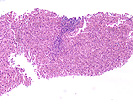
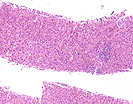
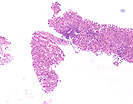
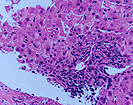
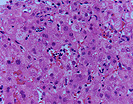
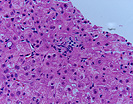
Please mail comments, corrections or suggestions to the TPIS administration at the
UPMC.
University of Pittsburgh. All rights reserved.
Unauthorized redistribution prohibited.





